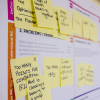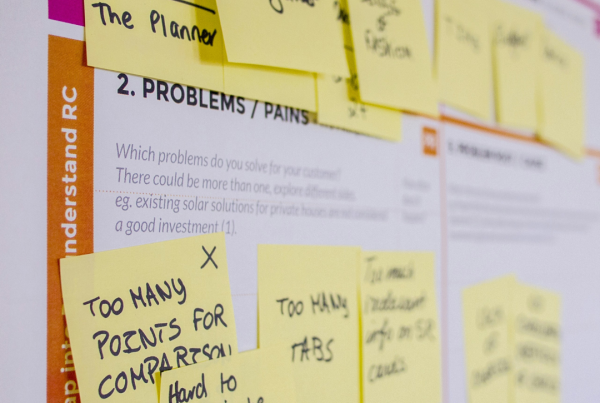Product leaders need to make the right decisions to continuously deliver value to users. However, every decision has an impact and cost attached to it, and requires effort. Some projects or product plans will not yield positive results while going over your budget and draining your resources and time.
This is where the impact-effort matrix comes in as a handy tool to help you prioritise product ideas, features, projects, and tasks while cutting out fruitless projects. Used extensively in the corporate world, you can customise the matrix to fit your product planning and road mapping needs. It’s a versatile tool that can empower product managers and teams to work smarter and deliver more benefits to customers.
The benefits of using the impact-effort matrix to make strategic product decisions are:
- It gives a balanced picture of the product for the short, medium, and long term.
- It helps identify the risks, effort, cost, and impact involved to simplify the decision-making process.
- It helps prioritise product features, product issues, and general direction.
- It aligns teams to focus on a common goal.
- It serves as a visual tool to communicate and inform stakeholders about product plans.
What is the impact-effort matrix?

The matrix is a plotted graph that shows the impact of a project or task against the effort required to deliver it. You’ll have four quadrants:
1. High Impact and Low Effort (Quick/Easy Wins): Items that give a high value that’s relatively easy to implement or require fewer resources. Typically, you’ll want to prioritise them. Some organisations refer to them as quick wins or low-hanging fruits.
2. High Impact and High Effort (Big Bets): These are your big-ticket items, as they are valuable but need more resources, time, and money. The conventional idea is that you need to plan and strategise for items in this quadrant for the medium to long term. This quadrant is sometimes referred to as major projects or big bets.
3. Low Impact and Low Effort (Fill-Ins): In this quadrant, you can delegate, outsource, or deprioritise them to a later date. Other names for this quadrant are fill-ins or nice-to-haves.
4. Low Impact and High Effort (Money Pits/Time Wasters): Items in this quadrant should, ideally, be eliminated or reduced. These are the money pits, time-wasters, and grandiose projects that barely deliver while draining your resources and budget.
When should you use the impact-effort matrix in product management?
While not a solution to every problem, the impact-effort matrix is valuable in certain stages of the product lifecycle, particularly when you need to plan and prioritise product plans, projects, and resources. Here’s when the matrix can help:
1. Product planning: When you need to draw a long-term picture that connects all the dots, the impact-effort matrix is especially useful. Drawing it out for everyone to see also helps to keep people focused on the problem, stay objective, and settle arguments.
2. Product feature prioritisation: This one is quite obvious, as the matrix will help determine the features that will give the highest positive impact on your users, while requiring minimal effort.
3. Product road mapping: This is another scenario where the impact-effort matrix should be used, where it will guide the product design and development’s timeline. You can also use it for sprint and release planning.
4. Resource allocation and optimisation: When you need to allocate resources while juggling multiple projects, the matrix will provide clarity and streamline your decision making. It’s also beneficial during the early stages of a startup, when you’re bootstrapped and need to make every resource and dollar count.
5. Product backlog management: When you’re faced with a long list of bugs to fix and features to upgrade, creating an impact-effort matrix will help you determine what’s important and de-prioritise others for later.
6. Regular product planning reviews: Plans may change, and this is when the impact-effort matrix can show gaps between reality and the original plan. You do this by monitoring the current value delivered and the effort required to reprioritise and re-strategise.
How to create the impact-effort matrix?
While creating the impact-effort matrix sounds straightforward, in reality, it may not be. The biggest challenge is getting a correct estimation for impact and effort, which is easier said than done because, in all honesty, you’re trying to predict the future based on past data.
So, how to measure impact and effort? It depends on your priorities, goals, and product.
Impact can be measured by looking at the expected impact on the product’s users or how many users the initiative will impact. You can extrapolate this figure based on previous user feedback and data. Another measure of impact is the monetary value a project delivers to the business in terms of sales, profit, or cost savings. Additionally, consider the impact on the market, product position against rival brands, and branding impact. You can combine all these indicators to give you an absolute number on a pre-defined scale.
In terms of deriving a value for effort, you’ll have to sift through past data and experiences, as every business does things differently. Some businesses outsource a lot of their resources, while others do everything in-house. You’ll also want to consider materials, tools, time, and the cost to estimate a value for effort. Some projects, features, and initiatives are easy to score, while others require further research and brainstorming.
The steps to create an impact-effort matrix are:
- Get teams and stakeholders to gather relevant data.
- Identify the current products and business goals.
- For every initiative, project, product feature, product upgrade, and plan, assign values for the impact and effort. Ensure each item is aligned with the product and business goals. If not, you’ll probably want to discard it.
- Chart all items on the quadrant.
- Discuss to reach a consensus among teams and stakeholders.
- Draft an action plan.
Caveat: The impact-effort matrix can be ineffective
Like any tool or method, it’s not foolproof. There are caveats attached to using the impact-effort matrix. However, the matrix is still a valuable method to set priorities and do big-picture planning; these FYIs are just something you need to aware of. So, what are the caveats?
Caveat #1: We tend to overestimate impact and underestimate effort.
This psychological terminology is called the planning fallacy, and is more common than you think. It’s when we are too optimistic about our assumptions, thinking that a task or project will take less time, less work, or require a lower cost than it does, while overestimating the value the project or task brings.
When there’s a planning fallacy, then the estimates you have are incorrect, rendering the impact-effort matrix useless. One way around this is to find a quick and low-cost way to test your estimates, so you can get more accurate figures. Having an archive of relevant metrics and results from past projects will also help.
Caveat #2: Estimates may become irrelevant.
As your organisation and teams grow bigger, you may encounter more red tape, or you’ll have longer processes in a project. If you’re outsourcing more work, workflows and timelines will also be affected. Miscommunication can occur more often. Thus, your estimates on how much work is required may no longer be relevant. This also applies to your impact estimates, especially when there are changing market conditions, new consumer behaviours, and technological advancements.
One workaround is to regularly review your estimates for each item in the quadrant. Be mindful of pursuing dead-end projects or initiatives that have failed to produce results. Some people find it hard to admit when their assumptions were wrong, especially when a lot of time, effort, and money have been poured into a project.
Caveat #3: Sometimes, you have to work on things that aren’t high priority.
A good example of this is design and technical debt. Sure, you can get away with all the hacks and workarounds you’ve put into the product. You can keep building more features into it and allow more integration to capture a bigger market share. However, debts will come back to haunt you, becoming liabilities one day. You will need to allocate time and resources to work on those things that aren’t seemingly high on the priority list.
Having listed all the caveats, I do think the impact-effort matrix is a valuable arsenal to use in product management and planning. You just need to know how to apply it correctly. It will save you time while streamlining some of your management work and avoiding second guessing on decisions.







